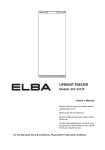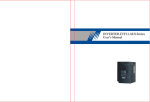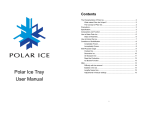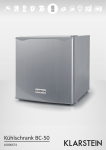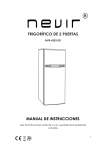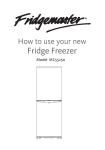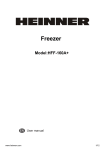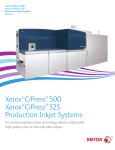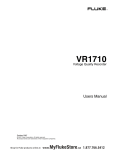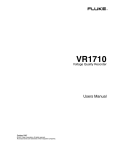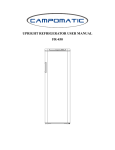Download Ariston UPRIGHT FREEZER NO FROST UP 350 FI (FE) User's Manual
Transcript
UP RI GHT FRE EZER MODEL:UP 350 FI (FE) Operating Instructions Dear customer, To enable you to use your new FREEZER effectively and safely, please read this instruction book carefully before you use the appliance, which contains important information for installation, safe use and maintenance of this appliance. Please keep the book for future reference and remember to pass it on to the new owner. The following symbols will be found in the book to guide you through the instructions: Guide to use the instruction book Warnings Operating instructions Tips and notes Warnings are stressed with a warning triangle or with signal words (Warning!, Important!), which are provided in the interest of your safety. Ensure that you understand them all before installing and using this appliance. Tips and notes will inform you with necessary knowledge of how to use the appliance economically and environmentally. Operating instructions presented in the section of “Trouble shooting” contain instructions for correction of possible malfunctions by users. 1 INDEX Important safety instructions ...........................................3 Installation ........................................................ 5 Description of the Appliance ...........................................6 Using Your Appliance .................................................7 Thermostat Control ................................................. 7 Hints and Tips .......................................................9 Energy Saving tips ...................................................10 Trouble Shooting ....................................................10 Regulations, Standards, Guidelines ..................................... 11 Correct Positioning ...................................................12 Disposal of the appliance .............................................14 Door Reverse Instructions .............................................15 2 Important safety instructions These warnings are provided in the interests of your safety.Ensure you fully understand them before installing or using the appliance. Your safety is paramount importance. If you are unsure about the meaning of these warnings contact the Customer Care Department for assistance. Intended use The freezer is intended for use in the home. It is suitable for the storage of food at low temperature. If the freezer is used for purposes other than those intended or used incorrectly,no liability can be accepted by the manufacturer for any damage that may be caused. Alterations or changes to the refrigerator are not permitted for reasons of safety. If you use the refrigerator in a commercial application or for purposes other than the cooling of foods, the manufacturer accepts no liability for any damages that may occur. Prior to initial start-up Check the appliance for transport damage.Under no circumstances should a damaged appliance be plugged in. In the event of damage, please contact your supplier. Refrigerant The refrigerant isobutene (R600a) is contained within the refrigerant circuit of the appliance,a natural gas with a high level of environmental compatibility, which is nevertheless flammable. During transportation and installation of the appliance, ensure that none of the components of the refrigerant circuit becomes damaged. The refrigerant (R600a) is flammable. Caution: risk of fire If the refrigerant circuit should become damaged: Avoid open flames and sources of ignition. Thoroughly ventilate the room in which the appliance is situated. The instructions shall include the warnings: WARNING!—Keep ventilation openings, in the appliance enclosure or in the built-in structure,clear of obstruction. WARNING!—Do not use mechanical devices or other means to accelerate the defrosting process, other than those recommended by the manufacturer. WARNING!—Do not damage the refrigerant circuit. 3 WARNING!—Do not use electrical appliances inside the food storage compartments of the appliance, unless they are of the type recommended by the manufacturer. WARNING!—This appliance is not intended for use by persons (including children) with reduced physical, sensory or mental capabilities, or lack of experience and knowledge, unless they have been given supervision or instruction concerning use of the appliance by a person responsible for their safety WARNING!—Young children should be supervised to ensure that they do not play with the appliance WARNING!—If the supply cord is damaged, it must be replaced by the manufacturer, its service agent or similarly qualified persons in order to avoid a hazard. WARNING!—When disposing of the appliance,do so only at an authorized waste disposal centre. Do not expose to flame. WARNING!—Please keep the appliance away from substance, which can cause ignition. WARNING!—Before obtaining access to terminals, all supply circuits must be disconnected. WARNING!—Please remove all the doors before you dispose your refrigerator. WARNING!—The fridge is only applied with power supply of single phase alternating current of 220~240V/50Hz.If fluctuation of voltage in the district of user is so large that the voltage exceeds the above scope, for safety sake, be sure to apply A.C.The fridge must employ a special power socket instead of common one with other electric appliances. Its plug must match the socket with ground wire. Safety of children Packaging (e.g. wraps, polystyrene) can be dangerous for children. There is a risk of suffocation! Keep packaging materials away from children! Remember to dispose the old appliance that is unusable. Pull out the mains plug, cut off the mains cable, break or remove spring or bolt catches if fixed. And ensure that children cannot lock themselves in the appliance when playing (there is risk of suffocation) or involve themselves in other dangers, for children cannot recognize the hazard present in household appliances themselves. Therefore, it is very important for parents to have adequate supervision in case children play with the appliance! Daily operation Containers with flammable gases or liquids can leak at low temperatures. There is a risk of explosion! Do not store any container with flammable materials such as spray cans in the refrigerator. Do not operate any electrical appliance in the refrigerator (e.g. electric ice cream makers, mixers etc.) 4 Before cleaning the appliance, always switch off the appliance and unplug it, or put the house fuse or switch off on the circuit breaker. In case of malfunction If a malfunction occurs, please look first in the “Trouble Shooting” section for help. If the information given there does not help, ask your supplier for help. Under no circumstances should you attempt to repair the appliance yourself, as repairs carried out by inexperienced persons may cause injuries or serious malfunctions. Installation Installation Location Before installing, carefully read the instruction in order to avoid a certain number of problems Positioning Position the appliance away from sources of heat such as stoves, radiators, direct sunlight etc. Maximum performance and safety are guaranteed by maintaining the correct indoor temperature for the class of unit concerned, as specified on the rating plate.This application perform well from N to ST.The Appliance may not work properly if it is left for a longer period at a temperature above or below the indicated range IMPORTANT! -There is a need of good ventilation around the fridge for easy dissipation of heat, high efficiency of refrigeration and low power consumption.For this purpose,sufficient clear.space should be available around the fridge. It is advisable for there to be 75mm separating the back of the fridge to the wall,at least 100mm of space at its two sides, height of over 100mm from its top and a clear space upfront to allow the doors to open 160. Climate class Ambient temperature SN +10 C to+32 C N +16 C to+32 C ST +16 C to+38 C T +16 C to+43 C Appliances must not be exposed to rain.Sufficient air must be allowed to circulate in the lower rear section of appliances,as poor air circulation can affect performance.Built-in appliances should be positioned away from heat sources such as heaters and direct sunlight. 5 Leveling The appliance should be level in order to eliminate rocking. To make the appliance level, it should be upright and both adjusters should be firmly contacted with the floor. You can also adjust the level by screwing out the appropriate level adjuster at the front (use your fingers or a suitable spanner), but much care should be taken when moving this appliance as it may be heavy. Description of the Appliance View of the appliance 1. Control panel 2. Ice tray (inside) 3. Upper drawer 4. Air outlet 5. Drawers 6. Drawers 9. Castors 10. Door 7. Drawer 8. Drawer Note: Due to the updated modifications of our products, your refrigerator may differ slightly from this Instruction Manual, but the functions and using methods remain the same. Freezer chamber For freezing and storing frozen foods, etc. 6 Ice tray For making ice, pour cool boiled water into the ice tray up to 4/5 of its volume, and place it in freezer compartment for 2 hours. When taking out ice tubes, twist the ice tray slightly, and the ice cubes are separated form the ice tray. Do not bend it, as it will crack. Freezer Drawers For freezing and storing frozen food. IMPORTANT! – in order to make the most of the volume of the fresh food storage compartment and frozen-food storage compartment, the user can removed one or more shelves, drawers, out of the appliance, according to your daily use. Using Your Appliance This appliance is designed for domestic use only, specifically for the storage of edible foods. And it is designed to operate in ambient temperatures (surrounding air temperature) between 16 C and 38 C. If the ambient temperature is either colder or warmer, the appliance will not work effectively and correctly. Should the ambient temperature be exceeded for a long period of time, the temperature in the freezer will rise above -18 Cand food spoilage may occur. Before use Remove all securing tapes. Wash the inside of the appliance with lukewarm water added with a little bicarbonate of soda (5ml to 0.5 liter of water). Do not use soap or detergent as the smell may linger. After cleaning, dry the appliance thoroughly. To start the appliance Operating instructions 1. Allow the appliance to stand for 2 hours after installation. 2. Plug in the appliance and turn on the power. 3. Turn the thermostat control to the required setting. A midway setting is usually suitable for normal operation. 4. Leave the appliance switched on for approximately 4 hours to reach the correct temperature before placing food inside. Thermostat Control The thermostat control panel controls the temperature inside the refrigerator compartment or freezer compartment, and is located on the top cover plate. 7 Super freeze Alarm + - Super freeze Alarm/M THERMOSTAT OF THE FREEZER COMPARTMENT If you press the ▲ or button, you can select the temperature ranging from -24 °C to -15 °C. If you ▲ press the ▲ or button once, the temperature will increase or decrease 1 °C,until the required ▲ temperature is displayed. SUPER FREEZE By simply pressing the super freeze button, the freezer will operate in the super freeze mode. The indicator light of super freeze will be on. In super freeze mode, the compressor will run continuously 26 hours and the temperature inside freezer will drop rapidly. Then the freezer will automatically quit the super freeze mode. The indicator light of super freeze will be off. Before that you can also manually quit the super freeze mode by pressing the super freeze button again. ALARM ALARM FOR DOOR If the door is left open for 2 minutes, the alarm will sound to remind you closing the door. If the door is still open, the alarm will sound 3 times per 30 seconds and last for 10 minutes. Then the alarm will automatically stop. ALARM FOR FREEZER The abnormal high temperature inside freezer might be resulted from: The freezer goes wrong. A long time of power cut. If the temperature inside the freezer rises to above -10 °C, the alarm will sound,at the same time the indicator light of alarm will begin to flash.If you don’t touch any button,the temperature display will flash and show the current temperature inside the freezer for about 10 seconds,then the temperature display show the selected temperature.And the alarm will sound 3 timesper 30 seconds and last for 2 minutes,then the alarm will automatically stop.If you press the Alarm/M button,the alarm is stop.And the indicator light of alarm will stop flashing.And the remperature display will show the highest temperature inside the freezer for 4 seconds,then show the selected temperature.When it reaches to bellow –10 °C,the indicator light of alarm will be off. NOTE: If the memory of the highest temperature inside the freezer is not deleted ,you can read it by 8 pressing the Alarm/M button. Under the High Temperature Alarm circumstance, if the Alarm/M button has not been pressed, the indicator light of alarm will flash continually even if the data the temperature display shows is bellow –10°C Hints and Tips Food storage Avoid buying frozen food if you cannot store it. Storage in original food containers is advisable. Place already frozen foods into the freezer as soon as possible, and be sure to: Not store too many items in the drawers. Allow air to circulate around each item. Not to store uncovered food. Ensure the foods placed in the freezer are dated and labeled, and used them in date order, so you can consume them at its best. Energy saving advice Do not place the appliance close to heat sources such as cookers, dishwashers or radiators. Make sure the appliance is placed in a cool well-ventilated room so that the air can circulate very well. Avoid unnecessary frosting in the cabinet by packing all foodstuffs into sealed packages. Avoid keeping the door open for a long time, as warm air will enter the cabinet and the cold air inside will leak out of the cabinet, which will cause energy wasting. Ensure that there is no obstruction preventing the door from closing properly. In the event of a power failure If there is a power failure while the appliance in operation, do not open the door. If the temperature inside your freezer should rise, causing food to defrost, do not refreeze the food. The following guidelines will assist you: Ice cream :Once thawed should be discarded. Fruit and vegetables: If soft should be cooked as soon as possible. Bread and cakes: Can be refrozen without danger. Shellfish: Should be refrigerated and used up quickly. Cooked dishes: i.e. casseroles, should be refrigerated and used up. Large pieces of meat: Can be refrozen if there are ice crystals remaining within them. Small joints: Should be cooked and then refrozen as cooked dishes. Chicken: Should be cooked and refrozen as a fresh dish. 9 Energy Saving tips 1. Do not place warm foods into the appliance. Allow warm foods to cool first. Do not install the appliance near cookers, radiators or other sources of warmth.High ambient temperatures cause longer, more frequent operation of the compressor. 2. In order to make the cooling system work efficiently,please make sure the side plates and back plate of the product are with some distance from the wall. It is strongly recommended that its back is 75mm away from the wall, its sides at least have a space of 100mm separately and the height from over its top is not less than 100mm. 3. When the product works, please do not open the door too often or leave the door open any longer than necessary. 4. Do not set temperature any colder than necessary. 5. The direct cooling refrigerator (with a freezer) needs to be defrosted when necessary. This will improve the cold transfer and reduce energy consumption. 6. The sketch map shows the right combination of the drawers, crisper and shelves which can lead to the more energy efficiency.If users adjust the combination,it would result in the energyconsuming. 7. Store food logically. Do not exceed the storage period specified Trouble Shooting Noises during Operation The following noises are normal characteristics of the appliance when it works: Whenever the compressor switches on or off, a click can be heard. As soon as the compressor is in operation, you can hear it humming. When refrigerant flows into thin tubes, you can hear bubbling or splashing noises. Even after the compressor has been switched off, the noise of splashing can be heard for a short time. Repairs to the freezer may only be conducted by qualified service engineers. Improper repairs can lead to significant hazards for users. If your appliance needs repairing, please contact your specialist dealer. 10 PROBLEM The freezer does not operate The freezer is too warm SOLUTION Check that it is properly plugged in, that the fuse has not blown or that the circuit-breaker has not tripped. Check the thermostat and make sure that the door stays open as little as possible. Also check that the door closes properly. Make sure that the freezer is well ventilated, leaving gaps as mentioned in the “Installation” chapter. Also check that your The motor runs continuously appliance is not exposed to a direct source of heat.You may also have placed too much food inside or the door may not close properly. Regulations, Standards, Guidelines This appliance is in accordance with the following EU guidelines: -73/23/EEC low voltage guidelines. -89/336/EEC EMC Directive -2009/125/EC framework for the settting of ecodesign requirements for energy-using -EC.643/2009. requirements four household refrigerating appliances. 11 Correct Positioning Good ventilation For the purpose of safety, reliance, low power consumption and durability to your freezer, a space should be left around thefreezer. please keep 75mm of space between the back of the appliance and the wall. Power supply The freezer is only suitable to a single–phase alternating 220V current of 220-240V, (50±1) Hz. ±10% Power Cord The cord should be neither lengthened nor folded into a coil during operation. Moreover, it is imperative not to keep the power cord close to, or touching the compressor at the back of the freezer, as the surface temperature is quite warm while operating, and touching may melt the insulation and cause electrical leakage. Protection from Moisture Avoid placing the freezer in a place where heavy moisture is present, to minimize the possibility of rusting any metal parts. It is imperative that the freezer not be directly sprayed with water, as it will cause poor insulation and current leakage may occur. 12 Level Surface The surface on which freezer is to be placed, must be flat and solid. It should not be laid on any soft material such as foam plastic, etc. if the freezer is not on level, adjust the casters. Protection from Heat The freezer should be far away from any heat source or direct sunshine. Keep Away from Danger It is not advisable for the freezer to be placed near any combustibles such as gas, petrol, alcohol, lacquer, banana oil, etc. The above-mentioned objects can not be stored in the freezer. Moving When moving the freezer, do not lie it horizontally or lower it at an angle less than 45°. 13 45° Disposal of the appliance It is prohibited to dispose of this appliance in domestic household waste. For disposal there are several possibilities: a) The municipality has established collection systems ,where electronic waste can be disposed of at least free of charge to the user. b) The manufacturer will take back the old appliance for disposal at least free of charge to the user. c) As old products contain valuable resources ,they can be sold to scrap metal dealers. Wild disposal of waste in forests and landscapes endangers your health when hazardous substances leak into the ground-water and fin their way into the food chain . Correct Disposal of this product This marking indicates that this product should not be disposed with other household wastes throughout the EU. To prevent possible harm to the environment or human health from uncontrolled waste disposal, recycle it responsibly to promote the sustainable reuse of material resources. To return your used device, please use the return and collection systems or contact the retailer where the product was purchased. They can take this product for environmental safe recycling. 14 Door Reverse Instructions The freezer is supplied with the door hinges on the right side. If you wish to change the opening direction, follow the instructions below: Warning! When changing the side at which the door opens, the appliance must not be connected to the mains. Remove plug from the mains beforehand. Tip: Food in the freezer should always be covered or packaged, to prevent drying and tainting of other food. The following are suited for packaging: Polyethylene airtight bags and wraps Plastic containers with lids Special plastic covers with elastic Aluminium foil Remove the three screws at the rear and the two screws at the top of the Upright Freezer and remove the lid. Use an 8mm spanner to remove the bolts from the top bracket. Lift the hinge bracket out of the recess in the door. Remove the pin from the bracket with a 10mm spanner /socket. Replace in the same hole through the other side. Remove the door. Lay the Upright Freezer backward. Remove the bottom hinge bracket using an 8mm socket or spanner. Remove the pin and replace on the opposite side using a 10mm socket or spanner. Reattach bottom bracket to the Upright Freezer. Replace leveling feet. Stand upright and replace door. 15 Insert top hinge bracket into the recess on top of the door. Bolt into place using the three bolts removed earlier. Remove blanking plates from the door handle to reveal screws. Remove the two screws that secure the handle. Replace and secure the lid of the Upright Freezer with the two top screws and the three rear screws from step 1. Cover the holes left by the removed screws with the blanking plates. Re-secure the door handle on the other side. Cover screws with the blanking plates. Check the door is aligned horizontally and vertically. Re-adjust the adjustable feet. 16

















